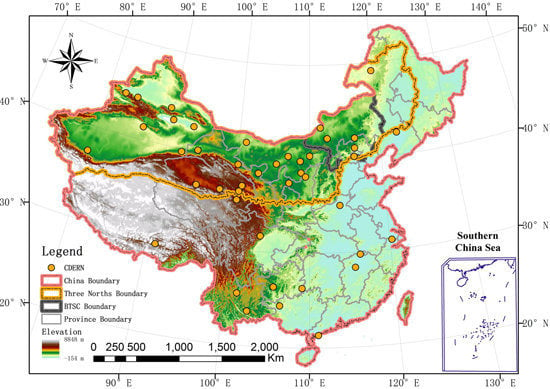Wind Erosion Induced Soil Degradation in Northern China: Status, Measures and Perspective
Abstract
:1. Introduction
2. Historical and Current Trends of Wind-Induced Soil Degradation in Northern China
2.1. Wind-Induced Soil Degradation in Northern China
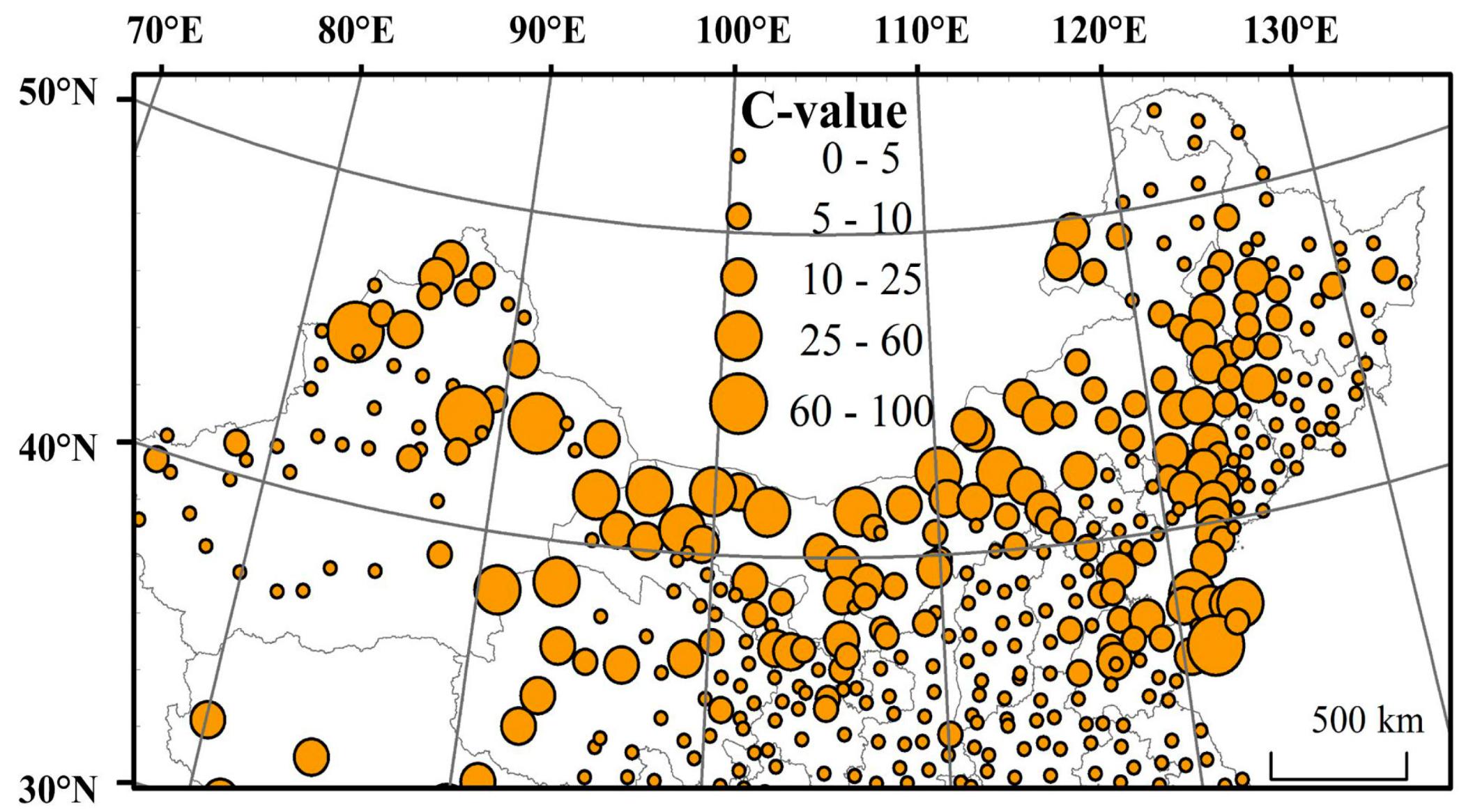

| Class | 1950s | 1975 | 1990 | 2000 | 2005 | 2010 |
|---|---|---|---|---|---|---|
| Area of the Class (km2)/Percentage of Total Area for the Class (%) | ||||||
| Slight | -- | 93,886.3/29.2 | 109,041.6/30.7 | 132,795.6/34.1 | 129,793.4/34 | 127,066.2/33.8 |
| Moderate | -- | 72,525.4/22.6 | 81,736.7/23 | 89,170.5/22.9 | 87,120.9/22.8 | 85,863.7/22.8 |
| Severe | -- | 76,851.7/23.9 | 83,477.1/23.5 | 85,969.2/22.1 | 84,086.7/22 | 83,307.3/22.2 |
| Very severe | -- | 78,204.1/24.3 | 81,050.7/22.8 | 81,785.1/21 | 80,543.8/21.1 | 79,735.9/21.2 |
| Total | ~295,000.0 | 321,430.4 | 355,268.8 | 389,683.7 | 381,507.3 | 375,935.5 |
| Class | Percentage of Blown Sand Area (%) | Percentage of Annual Increasing Area (%) | Percentage of Vegetation Cover (%) | Percentage of Annual Reduction in Biomass (%) |
|---|---|---|---|---|
| Slight | <5 | <1 | >60 | <1.5 |
| Moderate | 5–15 | 1–2 | 60–30 | 1.5–3.5 |
| Severe | 25–50 | 2–5 | 30–10 | 3.5–7.5 |
| Very severe | >50 | >5 | 10–0 | >7.5 |
2.2. Wind-Induced Soil Degradation for Typical Regions
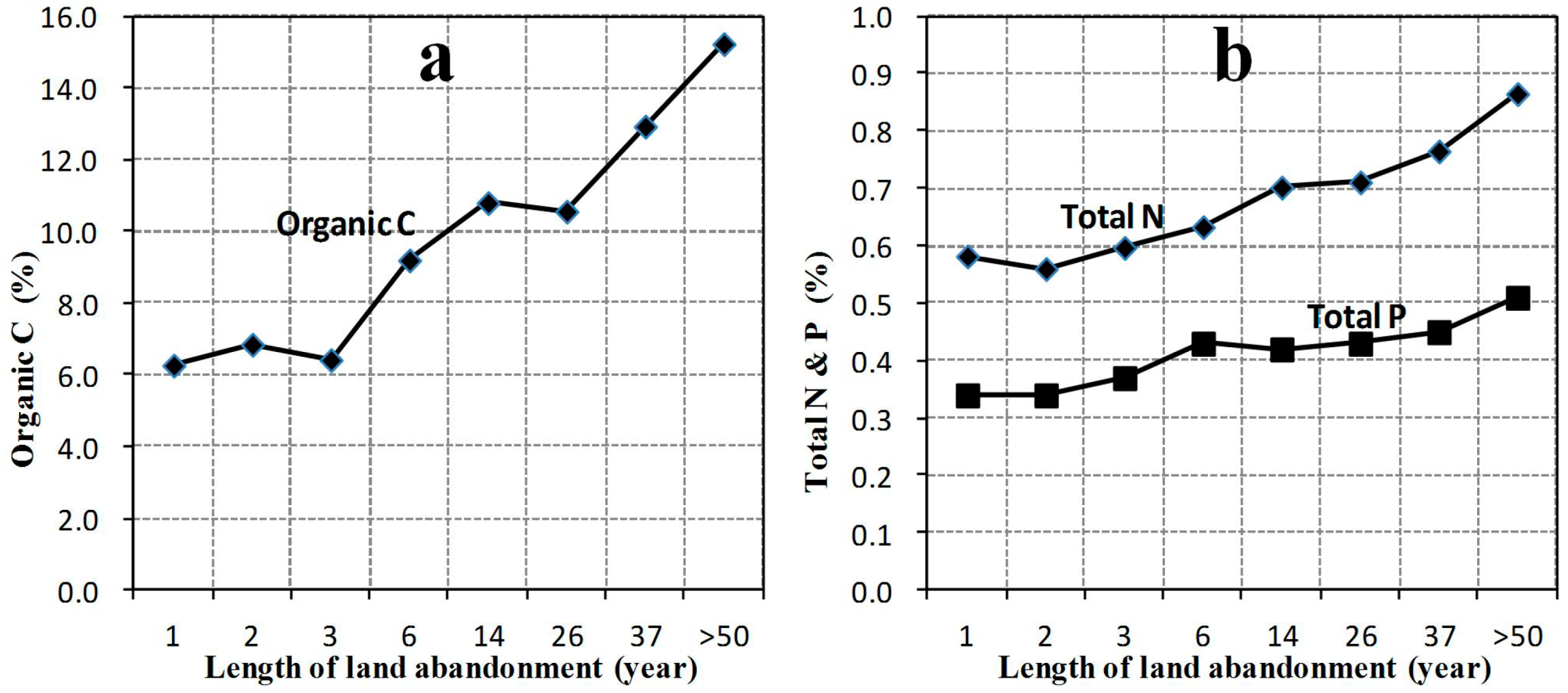
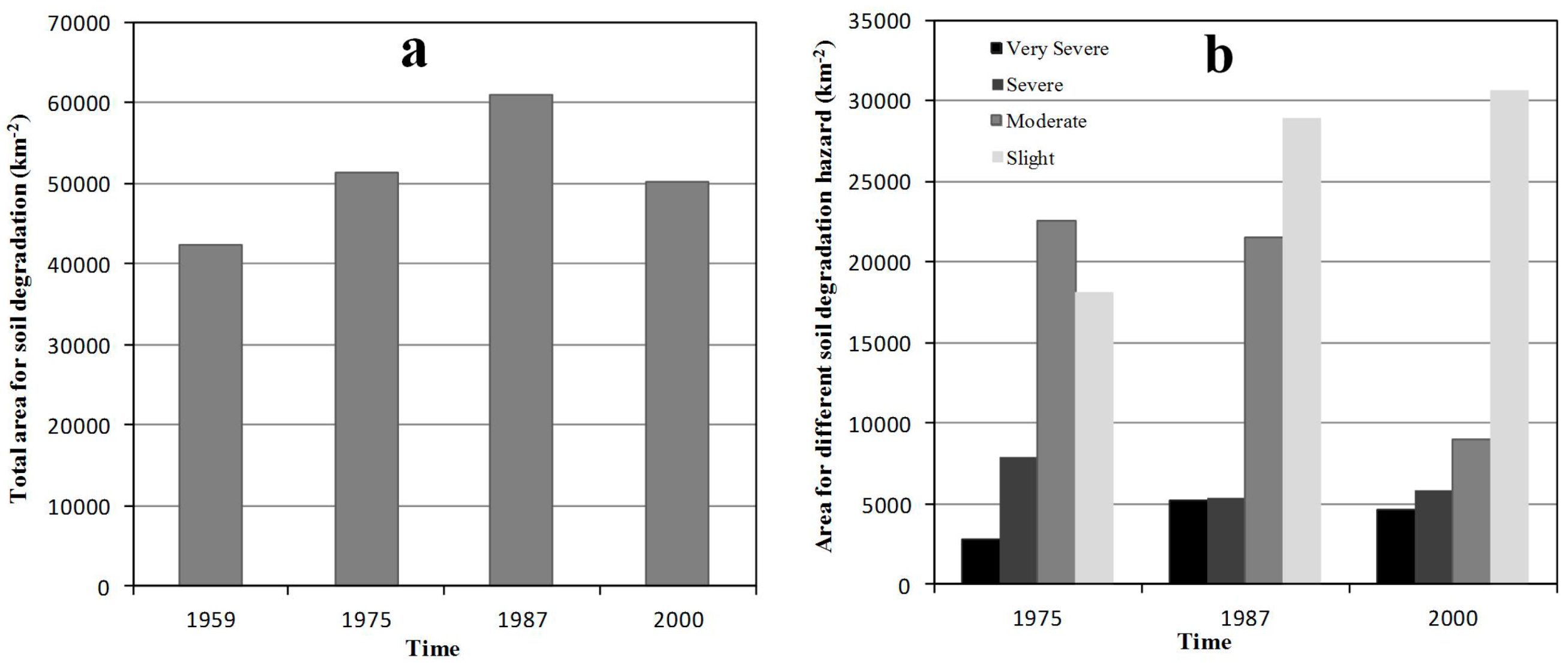
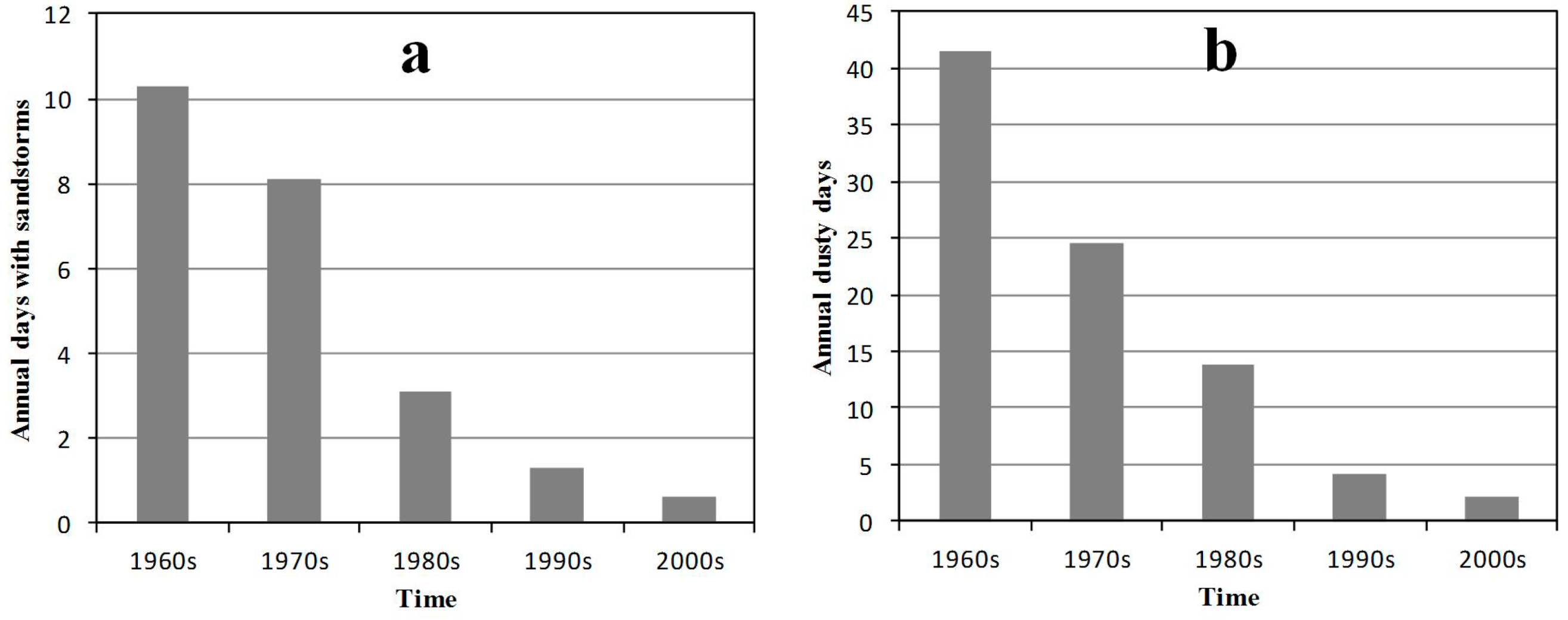
3. Current Land Management Practices Status
3.1. State Policy and Projects to Combat Wind-Induced Soil Degradation
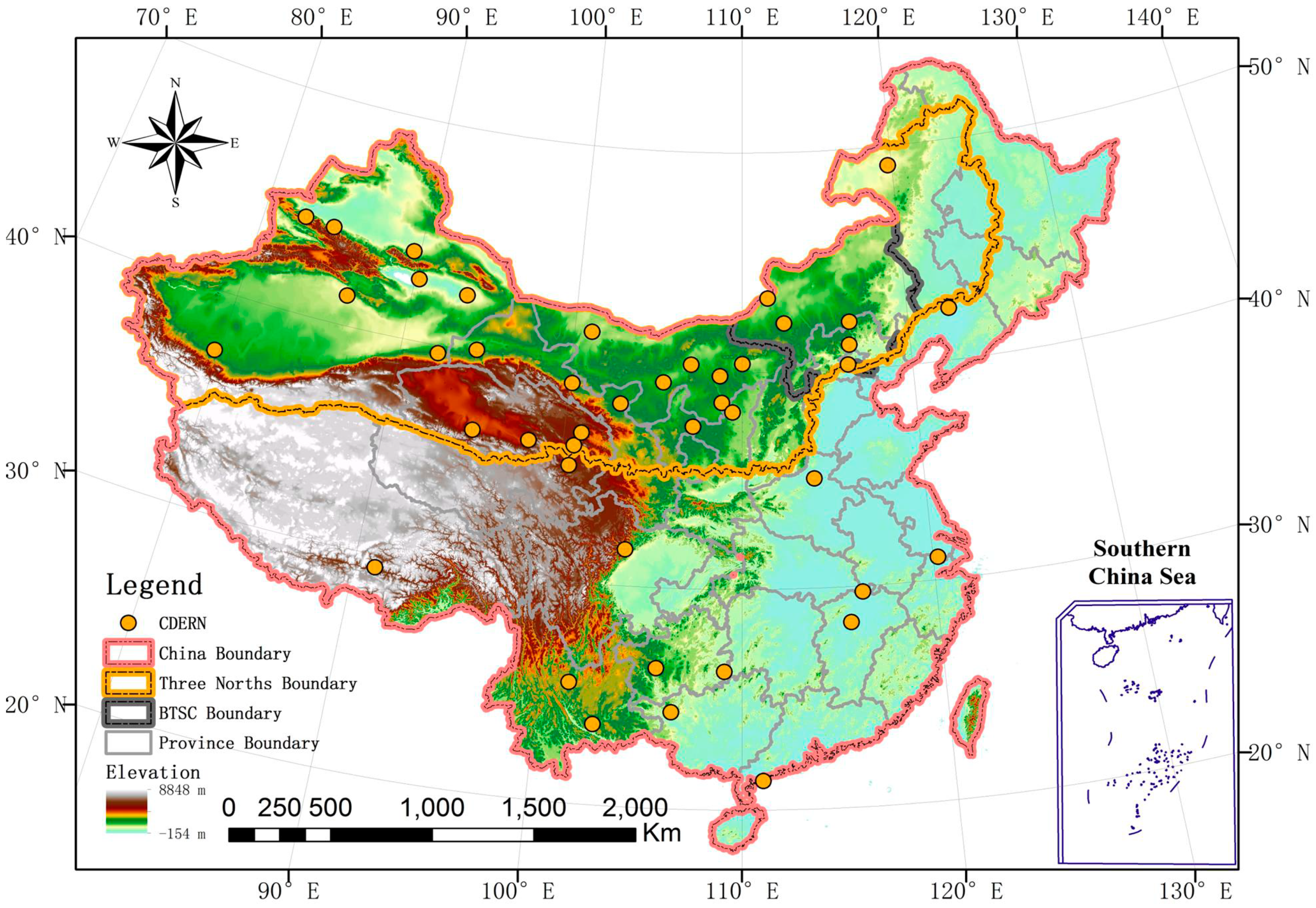
3.2. Current Land Management Practices Status for Different Landscape
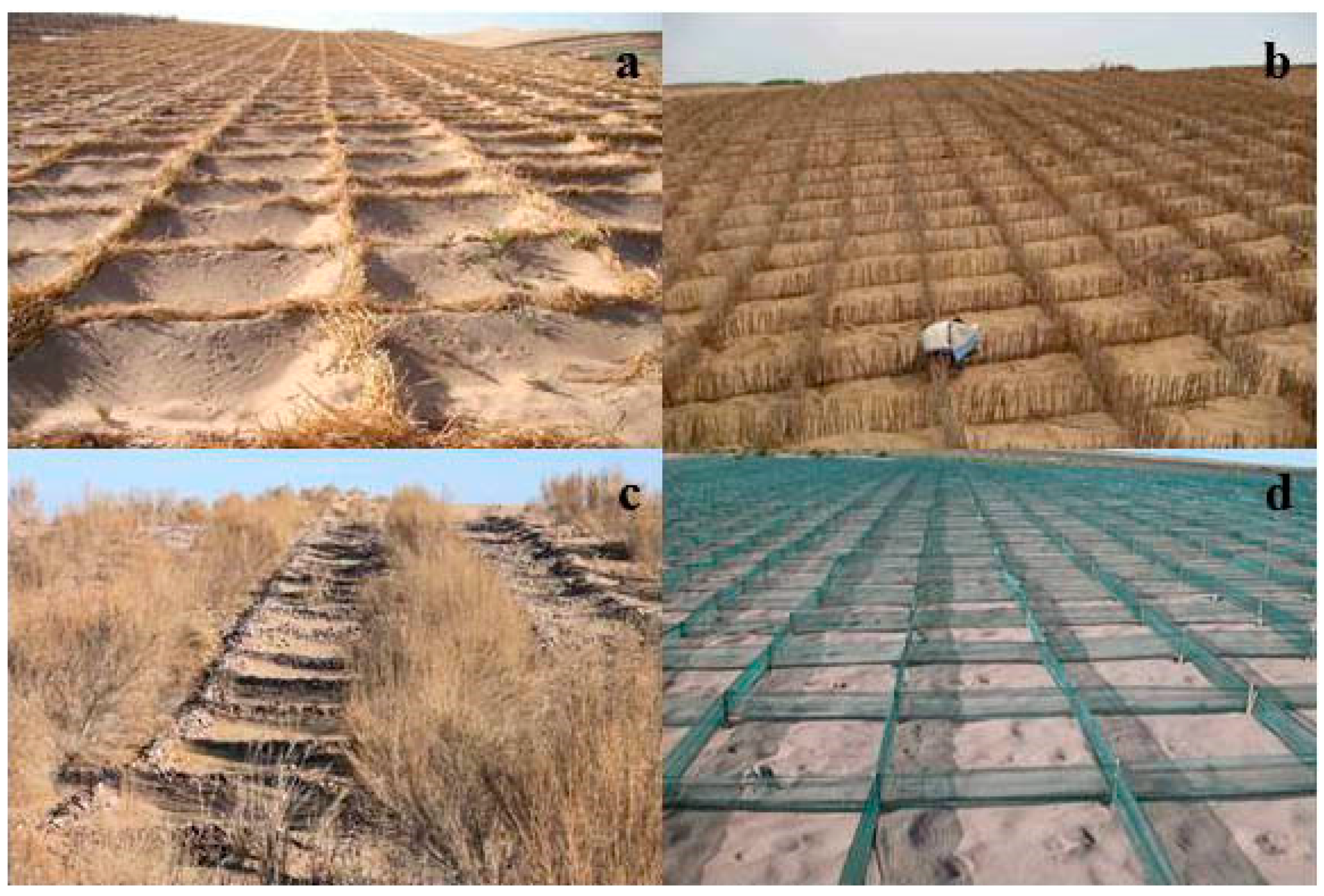
4. Perspectives on Reversing Wind-Induced Soil Degradation
5. Conclusions
Acknowledgments
Author Contributions
Conflicts of Interest
Disclaimer
References
- Karlen, D.L.; Andrews, S.S.; Weinhold, B.J.; Doran, J.W. Soil quality: Humankind’s foundation for survival. J. Soil Water Conserv. 2003, 58, 171–179. [Google Scholar]
- Wang, T. Progress in sandy desertification research of China. J. Geogr. Sci. 2004, 14, 387–400. [Google Scholar]
- Lal, R. Soil degradation by erosion. Land Degrad. Dev. 2001, 12, 519–539. [Google Scholar] [CrossRef]
- Dong, Z.; Wang, X.; Liu, L. Wind erosion in arid and semiarid China: An overview. J. Soil Water Conserv. 2000, 55, 439–444. [Google Scholar]
- Wang, T.; Song, X.; Yan, C.; Li, S.; Xie, J. Remote sensing analysis on aeolian desertification trends in northern China during 1975–2010. J. Desert Res. 2011, 31, 1351–1356. [Google Scholar]
- Wang, T.; Xue, X.; Luo, Y.; Zhou, X.; Yang, B.; Ta, W.; Wu, W.; Zhou, L.; Sun, Q.; Wang, X.; et al. Human causes of aeolian desertification in Northern China. Sci. Cold Arid Regions 2008, 1, 1–13. [Google Scholar]
- Wang, T.; Chen, G.; Zhao, H.; Xiao, H. Deserts and Aeolian Desertification in China; Science Press: Beijing, China, 2011. [Google Scholar]
- Wang, G.; Wang, X.; Wu, B.; Lu, Q. Desertification and its mitigation strategy in China. J. Resour. Ecol. 2012, 3, 97–104. [Google Scholar] [CrossRef]
- Ci, L.; Yang, X. Desertification and Its Control in China; Higher Education Press: Beijing, China; Springer-Verlag: Berlin-Heidelberg, Germany, 2010. [Google Scholar]
- Liu, B.; Qu, J.; Wagner, L.E. Building Chinese wind data for Wind Erosion Prediction System using surrogate US data. J. Soil Water Conserv. 2013, 68, 104A–107A. [Google Scholar] [CrossRef]
- Dong, Z.; Wang, T.; Qu, J. The history of desert science over the last 100 years. J. Desert Res. 2003, 23, 1–5. [Google Scholar]
- Wang, X.; Chen, F.; Hasi, E.; Li, J. Desertification in China: An assessment. Earth-Sci. Rev. 2008, 88, 188–206. [Google Scholar] [CrossRef]
- Wang, T.; Wu, W.; Xue, X.; Sun, Q.; Zhang, W.; Han, Z. Spatial-temporal changes of sandy desertified land during last 5 decades in northern China. Acta Geograohica Sinica 2004, 59, 203–212. [Google Scholar]
- Zhao, W.; Xiao, H.; Liu, Z.; Li, J. Soil degradation and restoration as affected by land use change in the semiarid Bashang area, northern China. Catena 2005, 59, 173–186. [Google Scholar] [CrossRef]
- Zhang, G.; Wang, C.; Bian, R.; Qu, X.; Yang, X. The climate change analysis of most typical region in Horqin sandy area for nearly 50 years. Chin. Agric. Sci. Bull. 2012, 23, 287–290. [Google Scholar]
- Fan, S.; Zhou, L. Desertification control in China: Possible solutions. AMBIO A J. Hum. Environ. 2001, 30, 384–385. [Google Scholar]
- Wang, F.; Pan, X.; Wang, D.; Shen, C.; Lu, Q. Combating desertification in China: Past, present and future. Land Use Policy 2013, 31, 311–313. [Google Scholar] [CrossRef]
- Zhao, J.; Wu, G.; Zhao, Y.; Shao, G.; Kong, H.; Lu, Q. Strategies to combat desertification for the twenty first century in China. Int. J. Sustain. Dev. World Ecol. 2002, 9, 292–297. [Google Scholar] [CrossRef]
- State Forestry Administration (SFA). National Report on the Three-North Shelterbelt Projects for Last 30 Years (1978–2008); China Forestry Press: Beijing, China, 2008. [Google Scholar]
- Yang, X.; Zhang, K.; Jia, B.; Ci, L. Desertification assessment in China: An overview. J. Arid Environ. 2005, 63, 517–531. [Google Scholar] [CrossRef]
- State Forestry Administration (SFA). National Report on Ecological Benefits of the Grain for Green Projects (2013); China Forestry Press: Beijing, China, 2013. [Google Scholar]
- Chinese Government Website. Available online: http://www.gov.cn/xinwen/201410/10/content_2 761817.htm (accessed on 17 October 2014).
- Gao, S.; Zhang, C.; Zou, X.; Wu, Y.; Wei, X.; Huang, Y.; Shi, S.; Li, H. Assessment on the Beijing and Tianjin Sandstorm Source Control Project, 2nd ed.; Science Press: Beijing, China, 2012. [Google Scholar]
- Zeng, X.; Zhang, W.; Cao, J.; Liu, X.; Shen, H.; Zhao, X. Changes in soil organic carbon, nitrogen, phosphorus, and bulk density after afforestation of the “Beijing–Tianjin Sandstorm Source Control” program in China. Catena 2014, 118, 186–194. [Google Scholar] [CrossRef]
- Cao, S. Why large-scale afforestation efforts in China have failed to solve the desertification problem. Environ. Sci. Tech. 2008, 42, 1826–1831. [Google Scholar] [CrossRef]
- Tong, C.; Wu, J.; Yong, S.; Yang, J.; Yong, W. A landscape-scale assessment of steppe degradation in the Xilin River Basin, Inner Mongolia, China. J. Arid Environ. 2004, 59, 133–149. [Google Scholar] [CrossRef]
- Qiu, G.; Lee, I.; Shimizu, H.; Gao, Y.; Ding, G. Principles of sand dune fixation with straw checkerboard technology and its effects on the environment. J. Arid Environ. 2004, 56, 449–464. [Google Scholar] [CrossRef]
- Ma, H.; Zhang, H.; Ma, L.; Ren, C.; Wang, Z.; Gao, X.; Fang, H.; He, X. None-watering and tube-protecting planting technique for Haloxylon ammodendron under desert and its extension. Sci. Sin. Vit. 2014, 44, 248–256. [Google Scholar]
- Zobeck, T.M.; Halvorson, A.D.; Wienhold, B.J.; Acosta-Martinez, V.; Karlen, D.L. Comparison of two soil quality indexes to evaluate cropping systems in northern Colorado. J. Soil Water Conserv. 2008, 63, 329–338. [Google Scholar]
- Wang, X.B.; Cai, D.X.; Hoogmoed, W.B.; Oenemad, O.; Perdok, U.D. Developments in conservation tillage in rainfed regions of North China. Soil Tillage Res. 2007, 93, 239–250. [Google Scholar] [CrossRef]
- Guo, Z.; Zobeck, T.M.; Zhang, K.; Li, F. Estimating potential wind erosion of agricultural lands in northern China using the Revised Wind Erosion Equation and geographic information systems. J. Soil Water Conserv. 2013, 68, 13–21. [Google Scholar] [CrossRef]
- Vigiak, O.; Sterk, G.; Warren, A.; Hagen, L.J. Spatial modeling of wind speed around windbreaks. Catena 2003, 52, 273–288. [Google Scholar] [CrossRef]
- Bao, Y.; He, X.; Yang, J.; Sun, C.; Li, H.; Zong, P. Study on preventing effect of three farmland shelter-forest network on soil wind erosion. Chin. J. Soil Water Conserv. 2007, 21, 5–8. [Google Scholar]
- Deng, L.; Sweeney, S.; Shangguan, Z. Long-term effects of natural enclosure: Carbon stocks, sequestration rates and potential for grassland ecosystems in the Loess Plateau. CLEAN-Soil Air Water 2014, 42, 617–625. [Google Scholar] [CrossRef]
- Jiang, D.; Miao, R.; Oshida, T.; Zhou, Q. Effects of fence enclosure on vegetation restoration and soil properties in Horqin sandy land. Ecol. Environ. Sci. 2013, 22, 40–46. [Google Scholar]
- William, D.M. Grassland enclosures: Catalyst of land degradation in Inner Mongolia. Hum. Org. 1996, 55, 307–313. [Google Scholar]
- Hu, Z. The importance of artificial grassland in the development of prataculture and the control of environment in China of 21 century. Grassl. Turf. 2000, 88, 12–15. [Google Scholar]
- Wang, Q.; Niu, D.; Jiang, W.; Ma, Y.; Li, Q. Effect and benef it of forage cultivation and livestock raising to the protection of ecosystem in the farming-pastoral region of Qiadam Basin. Acta Agrestia Sin. 2005, 13, 226–232. [Google Scholar]
- Wang, S.; Zheng, R.; Yang, Y. Combating desertification: The Asian experience. Internet For. Rev. 2000, 2, 112–117. [Google Scholar]
- Chen, Y.; Tang, H. Desertification in north China: Background, anthropogenic impacts and failures in combating it. Land Degrad. Dev. 2005, 16, 367–376. [Google Scholar] [CrossRef]
- Luca, S.; Marco, Z.; Margherita, C. Territorial systems, regional disparities and sustainability: Economic structure and soil degradation in Italy. Sustainability 2014, 6, 3086–3104. [Google Scholar] [CrossRef]
© 2014 by the authors; licensee MDPI, Basel, Switzerland. This article is an open access article distributed under the terms and conditions of the Creative Commons Attribution license (http://creativecommons.org/licenses/by/4.0/).
Share and Cite
Guo, Z.; Huang, N.; Dong, Z.; Van Pelt, R.S.; Zobeck, T.M. Wind Erosion Induced Soil Degradation in Northern China: Status, Measures and Perspective. Sustainability 2014, 6, 8951-8966. https://doi.org/10.3390/su6128951
Guo Z, Huang N, Dong Z, Van Pelt RS, Zobeck TM. Wind Erosion Induced Soil Degradation in Northern China: Status, Measures and Perspective. Sustainability. 2014; 6(12):8951-8966. https://doi.org/10.3390/su6128951
Chicago/Turabian StyleGuo, Zhongling, Ning Huang, Zhibao Dong, Robert Scott Van Pelt, and Ted M. Zobeck. 2014. "Wind Erosion Induced Soil Degradation in Northern China: Status, Measures and Perspective" Sustainability 6, no. 12: 8951-8966. https://doi.org/10.3390/su6128951
APA StyleGuo, Z., Huang, N., Dong, Z., Van Pelt, R. S., & Zobeck, T. M. (2014). Wind Erosion Induced Soil Degradation in Northern China: Status, Measures and Perspective. Sustainability, 6(12), 8951-8966. https://doi.org/10.3390/su6128951




